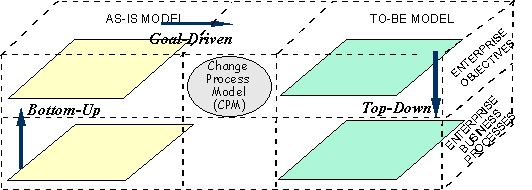
Roughly speaking, a route is characterised by the sequence of strategies it uses. What makes a route specific are the strategies selected in the route to fulfil the two EPI : Elicit Enterprise Goal Structure, Conceptualise Enterprise Business Process Model. More precisely, a route is a sequence of steps, each step corresponding to the achievement of an intention according to the selected strategy.
The EKD-CMM electronic guide book proposes three examples of routes. If these are not adequate for your own organisational change management project, you should construct your own EKD-CMM route through the EKD-CMM road map.
The table below sums up the three examples of pre-defined routes refered
to as "Top-Down" route, "Bottom-Up" route and "Goal-Driven" route.
|
Goal deployment | Evaluation | Process clustering | Analyst driven | Participative modelling |
|
|
T3 |
|
|||
|
|
|
|
|
|
|
| Goal-Driven | G3 | G4 | G2 | G1 |
As illustrated in the figure below:
- In the "Top-Down" route, the "first" step consists of eliciting the future goal structure and the second of conceptualising the future BPM. In other words, the first "shifting" between the two levels of concern is "from" the enterprise goals "towards" the enterprise business processes. The name "Top-Down" reflects this first shifting in the EKD-CMM product.
- In the "Bottom-Up" route, the "first" step consists of conceptualising the current BPM and the second of eliciting the current goal structure. In other words, the first "shifting" between the two levels of concern is "from" the enterprise business processes "towards" the enterprise goals . The name "Bottom-Up" reflects this first shifting in the EKD-CMM product.
- In the "Goal-Driven" route, "all" steps consist of processing with
enterprise goals.

Clearly, the two labels "Top-Down" and "Bottom-Up" were selected in regards to the movement from processes to goals whereas the "Goal-Driven" label stresses the fact that this route remains at the goal level.
In the table below, each step Ti, Bj or Gk is named by the intention
it aims to achieve completed by the strategy it uses to achieve it. The
name of the step refers to the page providing the guidelines to support
the step. Guidelines to perform each step are accessible by the name of
the corresponding modelling strategy (the blue underlined statements in
the table below).
| T1 | Elicit Future Goal Structure from Start following Participative Modelling Strategy |
| T2 | Conceptualise Alternative BPM from Future Goal Structure following Participative Modelling Strategy |
| T3 | Conceptualise Most Suitable BPM from Alternative BPM Scenaria following Evaluation Strategy |
| T4 | Conceptualise Future BPM from Selected BPM Scenario following Participative Modelling Strategy |
| T5 | Stop from Future BPM following Completeness Strategy |
| B1 | Conceptualise Current BPM from Start following Analyst Driven Strategy |
| B2 | Elicit Current Goal Structure from Current BPM following Process Clustering Strategy |
| B3 | Elicit Future Goal Structure from Current Goal Structure following Analyst Driven Strategy |
| B4 | Elicit Change Goal Structure from Current Goal Structure following Goal Deployment Strategy |
| B5 | Select Most Suitable Change Goal Structure from Change Goal Structure following Evaluation Strategy |
| B6 | Stop from Change Goal Structure following Completeness Strategy |
| G1 | Elicit Current Goal Structure from Start following Participative Modelling Strategy |
| G2 | Elicit Future Goal Structure from Current Goal Structure following Analyst Driven Strategy |
| G3 | Elicit Change Goal Structure from Current Goal Structure following Goal Deployment Strategy |
| G4 | Select Most Suitable Change Change Goal Structure from Change Goal Structure following Evaluation Strategy |
| G5 | Stop from Change Goal Structure following Completeness Strategy |